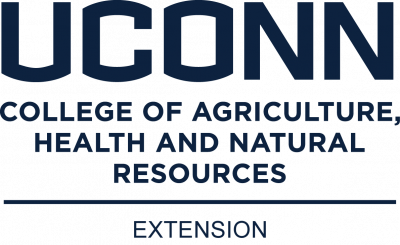By Victoria Wallace and Alyssa Siegel-Miles, UConn Extension
Regular scouting of turf and landscape areas for pests, including weeds, is a critical component of a strong Integrated Pest Management (IPM) program used in turf/landscape systems. When environmental conditions provide less than optimal growing conditions and turf is stressed, weeds can easily establish and compete for nutrients, sunlight, water, and space. Preventing conditions that allow for weed invasion and implementing proper cultural practices is key to sound turfgrass management.
The simplest definition of a weed is “a plant growing where it is not wanted.” When poor growing conditions create voids in turf, weeds inevitably fill those spaces. While weeds can be found in any location, many favor or populate in greater concentration in areas of specific soil conditions. These weeds, referred to as “indicator weeds,” provide “clues” relating to soil health, existing nutrients, growing site conditions, and the potential health of the turf.
Weeds are often removed as part of an overall maintenance program. Before eradication, the evident weeds can play a valuable role in a long-term, successful strategy to displace them and favor the desired turfgrass area. Modifying cultural practices or amending soil conditions that favor the health of the turfgrass stand will reduce weed populations. Whether weeds are removed mechanically or chemically, they will inevitably return if the conditions do not favor the turf and the underlying soil condition is not altered.
By recognizing the conditions that encourage turfgrass growth, site parameters can be identified to select the appropriate turf species. Growing conditions that compromise turfgrass health include: poor fertility, soil acidity, excess moisture, drought, compaction, and low light levels. To reduce weed infestations in a turfgrass stand, the soil and growing conditions must be adjusted to favor turfgrass growth. The site may need to be altered by renovating and/or overseeding with turfgrasses that are more tolerant of the existing site conditions.
The success of any weed management strategy should first depend on the correct identification and biology of the weed. Understanding the life cycle of weeds that are consistently present in a turfgrass stand helps to determine the most effective control strategy to discourage their growth. Then, coordinating the correct identification with the appropriate timing and method of eradication is critical.
Low Fertility Soils
Turfgrasses require adequate quantities of 16 essential nutrients for normal growth and development. These nutrients vary in the quantity in which they are needed to impact the health of the turf. Maintain the soil pH at 6.0-7.2 to maximize nutrient availability to turfgrasses. Have the soil tested every 1-3 years to monitor soil nutrient levels and pH. Follow soil test recommendations for applications of nitrogen (N), phosphorus (P) and potassium (K).
To minimize weed populations prevalent in low fertility soils, ensure the fertility program is appropriate for the existing or intended turf species. For areas of low fertility not subject to traffic and wear, overseed or renovate turf with fine fescues or turf-type tall fescues, which persist more favorably in soils of low fertility. Turf areas (e.g., athletic fields) that are under constant wear may require more frequent testing of soil nutrients and pH in order to dictate appropriate soil health. Low fertility, high traffic areas can be seeded with perennial ryegrass or turf-type tall fescue, but long-term, will have limited success in maintaining a dense playing surface without repeated overseeding.
Applications of nitrogen (N) products (either synthetic or organic) are necessary to sustain turf function. Nitrogen is the element needed in greatest quantity by turfgrass plants. Nitrogen stimulates shoot growth and contributes to the production of chlorophyll. Avoid excess applications of N, which encourage rapid shoot (leaf) growth, promote development of succulent leaf and root tissues that are more sensitive to the stress of heat and drought, and reduce both root growth and rooting depth.
- During cool temperatures, slow release fertilizer products are recommended, to extend the duration of nutrient release. Spring applications of N should be light (1/2 lb./1000 ft2), in order to promote healthy root and shoot (leaf) growth without overstimulating shoot growth.
- Use of organic products are recommended when warmer soil temperatures of late spring, summer, or early fall encourage microbial activity necessary to use or convert N for plant use.
- The bulk of annual N should be applied in the fall, after the dry and stressful summer season, to stimulate turfgrass recovery and increase chlorophyll/carbohydrate production needed for root development and winter survival.
- Corn gluten meal (CGM) is labeled as a pre-emergent herbicide, although its efficacy is unsubstantiated. It must be applied in early spring 2-4 weeks before the germination of summer grassy annuals (e.g., crabgrass), following label directions. CGM has a significant nitrogen component (usually 9-10%), releasing N slowly over a 3-4 month period following application. Use of this product as an herbicide at the label rate can inadvertently lead to an excess release of N. Therefore, if CGM is being used in a lawn maintenance program, its N component needs to be calculated into the overall nutrient management plan.
Two other elements, potassium (K) and phosphorus (P), are also important to encourage turfgrass survival and growth. Applications of K should be balanced with N. If K levels are deficient, as indicated by soil tests, K should then be applied at about half the level of N (Ebdon, 2015). Applications of phosphorus (P) are rarely needed for mature turfgrass in most soils. CT law stipulates that no applications of phosphorus can be made between Dec. 1 and March 15 in order to protect against P leaching into surface groundwater. Applications of P are not permitted unless a soil test (within 2 years) indicates a need for P (Henderson, Wallace, and Campbell, 2013).
USE THESE WEEDS TO IDENTIFY LOW FERTILITY SOILS:
| Common Name (Botanical Name) | Life Cycle |
| Annual bluegrass (Poa annua)* | Winter Annual |
| Black medic (Medicago lupulina)* | Summer Annual |
| Crabgrass (Digitaria spp.)* | Perennial |
| Plantain (Plantago spp.)* | Perennial |
| Red (sheep) sorrel (Rumex acetosella)* | Perennial |
| White clover (Trifolium repens)* | Perennial |
*Found in multiple categories.

Crabgrass (Digitaria spp.). Photo by Victoria Wallace.
Acidic Soils
Turfgrass grows best when the soil pH is between 6.0 and 7.2. In this range, most elements important for turfgrass growth are readily available to plants in a usable form. When the soil pH is too acidic, calcium, magnesium, and phosphorus become insoluble and unavailable. Acidic soils (at or below a pH of 5.5) may elevate levels of aluminum and manganese to a degree that is toxic to turfgrass health.
To reduce populations of weeds prevalent in acidic soils, steps can be taken to increase the pH of the soil, so that the turfgrasses can thrive. A soil with an acidic pH, confirmed with a soil test, can be slowly raised through periodic applications of lime (hydrated lime, calcitic limestone, or dolomitic limestone). Applications to increase pH are most effective when spread and incorporated into the soil during the establishment of a new turfgrass stand. For established turf areas, lime can be applied annually or as needed. Soil test results include recommendations for the quantity of limestone needed to raise the pH. Alternately, turfgrasses that better tolerate acidic soils, such as fine fescues, can be overseeded to alter the composition of the turfgrass stand. Fine fescues can persist in acidic soils and should be considered for lawn areas not prone to heavy wear.
USE THESE WEEDS TO IDENTIFY ACIDIC SOILS:
| Common Name (Botanical Name) | Life Cycle |
| Broadleaf plantain (Plantago major)* | Perennial |
| Silver cinquefoil (Potentilla argentea)* | Perennial |
| Hawkweed (Hieracium spp.) | Perennial |
| Red (sheep) sorrel (Rumex acetosella)* | Perennial |
| Sowthistle (Sonchus spp.) | Perennial |
*Found in multiple categories.
Wet Soils
If weeds predominate in turf areas that are often wet, it is important to understand why the area is wet before attempting to correct the situation. Common reasons, and potential solutions, include:
Excessive irrigation
- Irrigate for the needs of the turf, not the competing weeds. Water based on need, rather than timed, biweekly events. Where possible, water sensors should be installed on all irrigation systems. Perform an audit on the irrigation system to ensure it is running properly, providing uniform coverage, and that sprinkler heads are directed to the turf, not driveways or roads. For mature lawns, water deeply and infrequently, to encourage turfgrass rooting deeper into the soil. Irrigate before mild drought stress is visible (leaf folding and footprinting).
- Poor drainage/compaction: symptoms include standing puddles/lack of water infiltration. See the “Compacted Soils” section for tips on how to improve drainage and reduce compaction.
Naturally occurring wetland conditions or manmade low areas in the landscape
If the wet area is a managed turf area:
- Overseed with turfgrasses that tolerate or prefer wet soils. Perennial ryegrass (Lolium perenne) and Kentucky bluegrass (Poa pratensis) are more tolerant of wet soils than fine or tall fescues (Festuca). For non-athletic field areas, rough-stalked bluegrass (Poa trivialis), which prefers wet and shady growing conditions, may be purchased from a seed supplier that produces custom turfgrass seed mixtures.
- Alternately, improve the drainage and porosity of the soil.
- Incorporate compost and other organic amendments or sand into the soil to improve aeration and drainage (confirm the existing organic matter content with a soil test before adding).
- Aerate to improve oxygen levels within the soil and encourage the downward movement of soil water, especially if the soil is compacted.
- Raise the elevation of the low spot by adding and incorporating soil or moving soil from high points of the landscape to fill low areas.
- Improve sub-surface drainage by installing pipe drains, interceptor drains (i.e., French drains), trackside drains, strip drains and sand-slit drains. Divert or collect excess water.
For excessively wet outlying areas, consider options that provide an alternative to maintaining mown turf, such as converting the area to buffer strips or a rain garden. Rain gardens allow rainwater runoff to infiltrate and be absorbed into the soil. Stormwater is cleansed, its infiltration rate is slowed, and its volume is reduced as it moves through a rain garden. Specific, appropriate plants, which can withstand the extremes of moisture and concentrations of nutrients (particularly nitrogen and phosphorus) often found in stormwater runoff, are utilized.
USE THESE WEEDS TO IDENTIFY WET SOILS:
| Common Name (Botanical Name) | Life Cycle |
| Annual bluegrass (Poa annua)* | Winter Annual |
| Common chickweed (Stellaria media)* | Winter Annual |
| Mouse-ear chickweed (Cerastium virgatum)* | Perennial |
| Yellow nutsedge (Cyperus esculentus) | Perennial |
*Found in multiple categories.
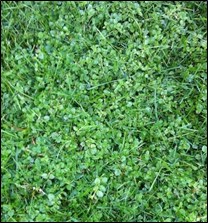
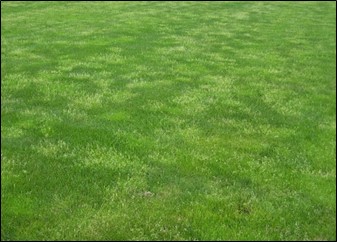
Drought-Prone Soils
The composition and texture of the soil (i.e., sand, silt, or clay) influences the soil’s ability to retain water, which dictates how, and at what pace, water moves through the soil. Soils high in clay, silt, and organic matter hold water more readily than others. Soils that are sandy or low in organic matter are prone to drought, because water moves quickly though the soil profile, causing the top layers of the soil to dry out rapidly. Turfgrasses grown in these soils quickly become drought stressed when evaporation and transpiration rates (influenced by heat, dry air, and wind) are high.
A soil in good health has a higher capacity to retain water to ensure healthy turfgrass growth and influence the success of a lawn maintenance program. Soil management practices that improve soil quality and the ability to retain water, enabling turfgrasses to tolerate periods of drought are:
- Add organic matter to the soil to improve soil texture. Leaf mulch and compost are good options. Organic material will improve the soil structure and encourage beneficial microbial activity.
- Ensure that soil is covered by dense and uniform turf to moderate soil temperatures. Overseed any bare spots or areas of poor turf density.
- Overseed with turfgrass species or cultivars with improved tolerance to drought. Turf-type tall fescues and fine fescues have excellent drought tolerance, although fine fescues are not appropriate for areas of intense wear. Cultivars of Kentucky bluegrass and perennial ryegrass that show improved drought tolerance also may be considered in a seed mixture.
- Maintain soil at a neutral pH (6.0-7.2) to encourage optimal turfgrass growth.
- Potassium nutrition is closely linked to a soil’s ability to retain water. Optimum levels of potassium supplied in the soil improve the turf’s ability to withstand drought stress.
- Alleviate soil compaction, which negatively impacts soil quality and limits root growth. Avoid heavy foot or vehicle traffic on turf, especially during periods of drought stress or when turf is dormant (for non-irrigated turf).
USE THESE WEEDS TO IDENTIFY DROUGHT-PRONE SOILS:
| Common Name (Botanical Name) | Life Cycle |
| Black medic (Medicago lupulina) | Summer Annual |
| Crabgrass (Digitaria spp.) | Summer Annual |
| Goosegrass (Eleusine indica)* | Summer Annual |
| Plantain (Plantago spp.)* | Perennial |
| Silver cinquefoil (Potentilla argentea)* | Perennial |
| Prostrate knotweed (Polygonum aviculare)* | Summer Annual |
| Red (sheep) sorrel (Rumex acetosella)* | Perennial |
| Spotted spurge (Euphorbia maculata)* | Summer Annual |
| White clover (Trifolium repens)* | Perennial |
| Woodsorrel (Oxalis stricta) | Perennial |
*Found in multiple categories.
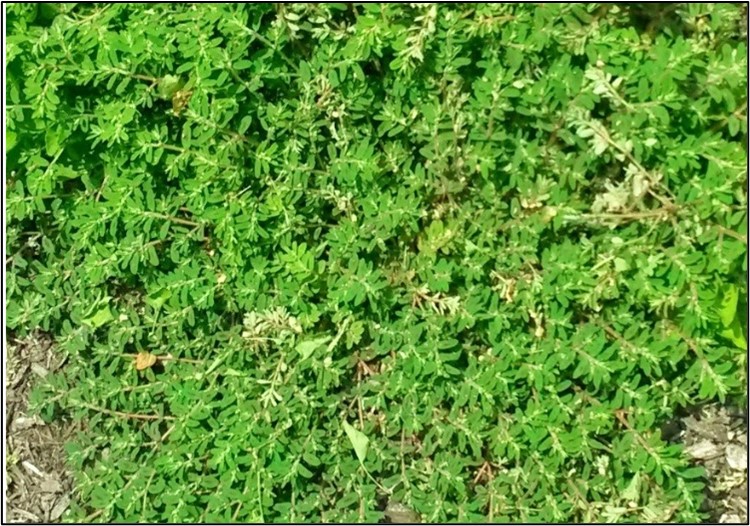
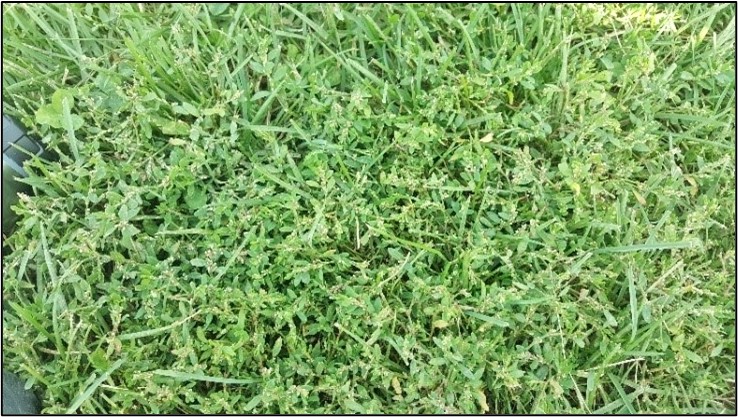
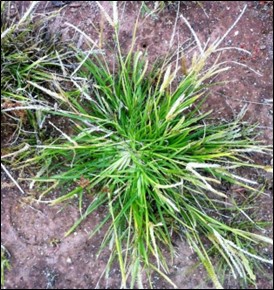
Compacted Soils
Healthy soil contains 50% particles (sand, silt, or clay), including up to 5% organic matter, and 50% pore space, for air and water movement around the particles (Voyle, 2014). When soil particles are pressed together, by excessive foot or vehicular traffic or repetitive cultivation when the soil is wet, too little space remains for the air that is needed to maintain healthy roots. Soils with a high clay content are especially prone to compaction. Water struggles both to infiltrate and drain from heavily compacted soils, increasing erosion and flooding. Challenged root growth leads to reduced water and nutrient uptake, and in dry soils, compacted turf is often drought-stressed. Wet compacted soils often contribute to weakened and disease-prone turf.
Soil aeration or core aeration can alleviate compaction in turf areas, allowing air, water and nutrients to enter the soil. Areas that have been aerated can then be topdressed with a coarse-textured material, such as sand or compost, to increase soil porosity. When overseeding, select compaction-tolerant turfgrass species, such as perennial ryegrass, as a major component of the seed mix. This helps to sustain turf density in compaction-challenged soils and reduces the opportunity for compaction-tolerant weeds to establish.
Athletic fields and golf course fairways are regularly cultivated to alleviate compaction. The type of cultivation and timing of cultivation events vary with the season and activity level of the area. Home lawns, which are often surrounded by extensive tree root systems, also require regular cultivation to reduce compaction and improve turfgrass health. Core aerators, which are used to alleviate compaction, can be contracted by landscape professionals or rented from lawn and garden stores.
USE THESE WEEDS TO IDENTIFY COMPACTED SOILS:
| Common Name (Botanical Name) | Life Cycle |
| Annual bluegrass (Poa annua)* | Winter Annual |
| Broadleaf plantain (Plantago major)* | Perennial |
| Chicory (Cichorium intybus) | Perennial |
| Common chickweed (Stellaria media)* | Winter Annual |
| Corn speedwell (Veronica arvensis) | Winter Annual |
| Dandelion (Taraxacum officinale) | Perennial |
| Goosegrass (Eleusine indica)* | Summer Annual |
| Mouse-ear chickweed (Cerastium virgatum)* | Perennial |
| Path rush (Juncus tenuis) | Perennial |
| Prostrate knotweed (Polygonum aviculare)* | Summer Annual |
| Spotted spurge (Euphorbia maculata)* | Summer Annual |
| White clover (Trifolium repens)* | Perennial |
| Wild garlic (Allium vineale) | Perennial |
*Found in multiple categories.
Areas of Low Light/Heavy Shade
Some turf weed invaders, especially moss and algae, are an indication that the area is too shady for most commonly grown turfgrasses. Turfgrasses require at least 4-6 hours of sun per day. With less, turfgrass stands will be thin with open spaces. To improve conditions for enhanced turgrass health:
- Overseed with turfgrass species that best tolerate shady conditions, such as fine and tall fescues. Kentucky bluegrass and perennial ryegrass require more than 6 hours of sunlight a day.
- Employ good cultural practices: increase mowing height, irrigate deeply and infrequently, and aerate the soil annually. Prune trees and shrubs to improve light penetration and increase air circulation.
- Moderate fertility practices. While tree roots compete with turfgrasses for nutrients and water, shaded established lawn areas often need less nitrogen than full sun areas, because turfgrasses photosynthesize less and grow more slowly. 1-2 lbs. of N/1,000 sq.2 per season is all that is recommended in shade, compared to 2-4 lbs./1,000 sq.2 in full sun. Established areas also mineralize N, leading to a buildup of N in organic matter.

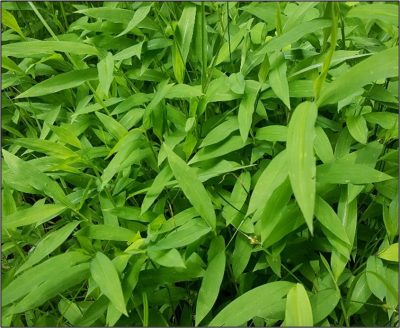
USE THESE WEEDS TO IDENTIFY AREAS OF LOW LIGHT/HEAVY SHADE:
| Common Name (Botanical Name) | Life Cycle |
| Algae | Perennial |
| Annual bluegrass (Poa annua)* | Winter Annual |
| Common chickweed (Stellaria media)* | Winter Annual |
| Ground ivy (Glechoma hederacea) (CT Invasive) | Perennial |
| Japanese stiltgrass (Microstegium vimineum) (CT Invasive) | Perennial |
| Mouse-ear chickweed (Cerastium virgatum)* | Perennial |
| Moss (e.g., Polytrichum juniperinum) | Perennial |
| Nimblewill (Muhlenbergia schreberi) | Perennial |
| Poison ivy (Toxicodendron radicans) | Perennial |
| Violets (Viola spp.) | Perennial |
*Found in multiple categories.
With inadequate levels of light, the area may be too shady for healthy turfgrass growth. Along landscape edges, where turf is most challenged, consider substituting turf with tough, shade tolerant groundcovers:
barrenwort (Epimedium spp.)
blue wood aster (Symphyotrichum cordifolium)
Canada mayflower (Maianthemum canadense)
creeping phlox (Phlox stolonifera)
foamflower (Tiarella cordifolia)
green-and-gold (Chrysogonum virginianum)
hay-scented fern (Dennstaedtia punctilobula)
marginal shield fern (Dryopteris marginalis)
Pennsylvania sedge (Carex pensylvanica)
plantain-leaved sedge (Carex plantaginea)
white wood aster (Eurybia divaricata)
wild ginger (Asarum canadense)
Alternately, keep bare soil areas covered with mulch (e.g., bark, wood chips, straw) to reduce erosion of exposed soil areas. Consider alternative mulching products, such as small stones or pebbles
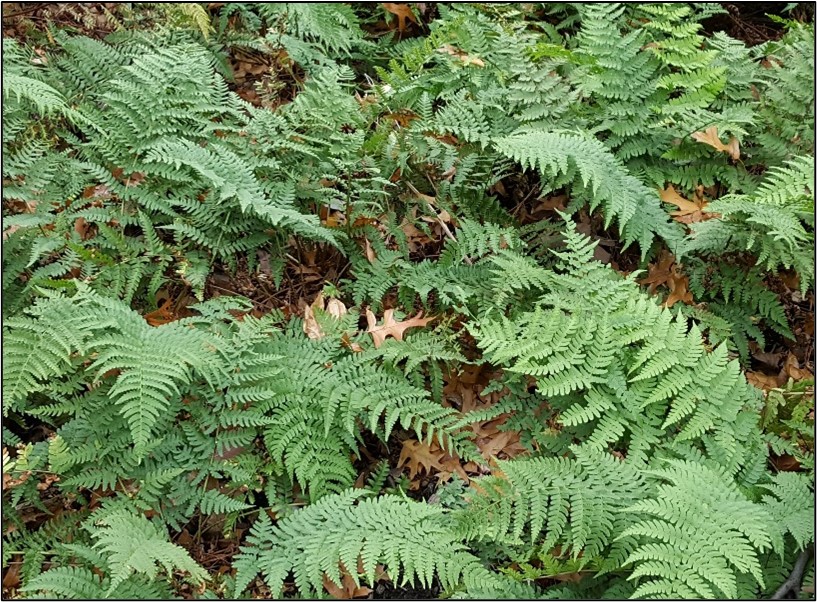
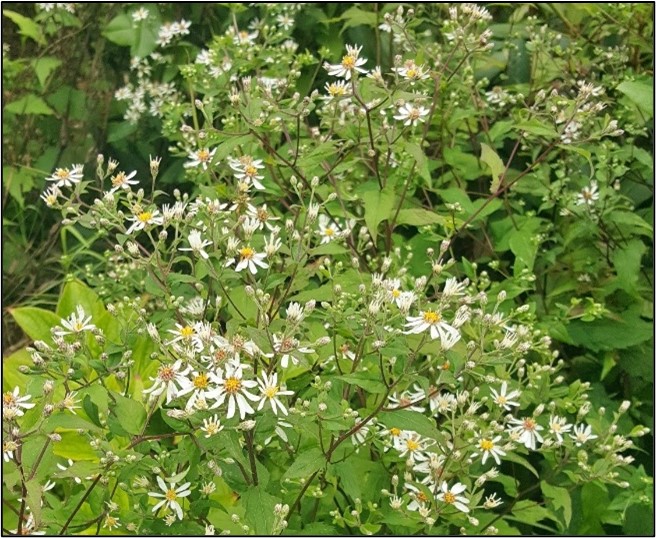
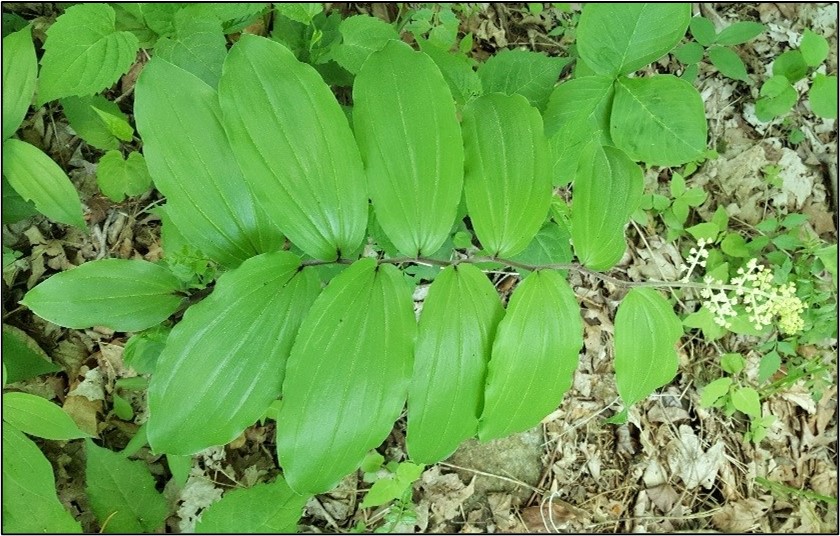
Please note:
While the consistent presence of some weeds found in specific locations can be a useful indicator as a soil health diagnostic tool, most weeds are found to grow in a variety of conditions. It cannot be assumed that a given condition exists based solely on the presence of a specific weed. For best results, take a soil test before amending any soil. For instructions, visit http://www.soiltest.uconn.edu/sampling.php or call the UConn Soil testing lab at (860) 486-4274 or the UConn Home and Garden Education Center toll-free at (877) 486-6271.
Weed Scouting Calendar:

Glossary:
Annual: a plant that completes its life cycle from seed to mature plant in one year. Winter annuals complete their life cycles from fall to spring. Summer annuals complete their life cycle from spring to fall.
Biennial: a plant that completes its life cycle in two years. Flowering and seed production take place in the second year.
Buffer Strip: an area of land maintained in permanent vegetation designed to intercept pollutants and manage other environmental concerns, helping to control air, soil, and water quality.
Integrated Pest Management: IPM is a sustainable and scientific approach to pest control that strives to address and correct the root causes of weed problems rather than just the symptoms. Multiple techniques (e.g., cultural, mechanical, chemical, biological) are employed for an overall strategy that is effective, economical, and ecologically sustainable.
Non-Vascular: a plant that does not have vascular tissue (xylem and phloem) for the transport of water and other nutrients. Mosses, liverworts and hornworts are non-vascular.
Perennial: a plant that lives more than two years and continues growing until it reaches maturity (3-5 years on average).
Bibliography:
- Botts, B. (n.d.). The Language of Weeds. Chicago Botanic Garden. chicagobotanic.org/plantinfo/smart_gardener/language_weeds
- Charbonneau, P. & Hsiang, T. (2015). Integrated Pest Management for Turf. Ontario, Canada: Ministry for Agriculture, Food, and Rural Affairs.
- Danko, L. (2014). Rain Gardens - the Plants. PennState Extension. extension.psu.edu/plants/gardening/eco-friendly/rain-gardens/plants-rain-gardens
- Derr, J. F. (2000). Weeds as Indicators of Environmental Conditions. Turfgrass Trends.
- Ebdon, J. S. (2015). Water Conservation for Landscape Turf. UMass Extension. ag.umass.edu/turf/fact-sheets/water-conservation-for-landscape-turf
- Henderson, J., Wallace, V. & Campbell, J. (2013). Best Management Practices for Pesticide-Free, Cool-Season Athletic Fields. University of Connecticut Extension.
- Hill, S.B. & Ramsay, J. (1977). Weeds as Indicators Of Soil Conditions. Ecological Agriculture Projects. eap.mcgill.ca/publications/EAP67.htm
- Kujawski, R. (Revised 2011). Long-term Drought Effects on Trees and Shrubs. UMass Extension. ag.umass.edu/landscape/fact-sheets/long-term-drought-effects-on-trees-shrubs
- Landschoot, P. (2016). Turfgrass Fertilization: A Basic Guide for Professional Turfgrass Managers. Penn State Extension. plantscience.psu.edu/research/centers/turf/extension/factsheets/turfgrass-fertilization-professional
- McKenzie, R. H. (2003). Soil pH and Plant Nutrients. Alberta Agriculture, Food and Rural Development. www1.agric.gov.ab.ca/$department/deptdocs.nsf/all/agdex6607/$file/soilph.pdf?OpenElement
- New Jersey Agricultural Experiment Station. (n.d.). Drought Resources. Rutgers University. njaes.rutgers.edu/drought/
- RHS. (n.d.). Waterlogged lawns. rhs.org.uk/lawns/waterlogging
- Rossi, F. & Schimenti, C. (n.d.). Drainage management. Cornell Turfgrass. safesportsfields.cals.cornell.edu/drainage
- The Lawn Institute. (n.d.). Weeds are Indicators of Soil Problems.
- Turgeon, A. J. (n.d.). Turfgrass Management. Reston, Virginia: Reston Publishing Co, 1980.
- Snohomish Conservation District. (2015). Fall is a Great Time to Lime. snohomishcd.org/blog/2015/9/16/fall-is-a-great-time-to-lime
- University of Illinois Extension. (n.d.). Lawn Talk: Solving Moss Problems in Lawns. extension.illinois.edu/lawntalk/weeds/solving_moss_problems_in_lawns.cfm
- Voyle, G. & Hudson, H. (2014). What to do about compacted soil. Michigan State Extension. msue.anr.msu.edu/news/what_to_do_about_compacted_soil
Questions? Contact:
Vickie Wallace
UConn Extension
Extension Educator
Sustainable Turf and Landscape
Phone: (860) 885-2826
Email: victoria.wallace@uconn.edu
©UConn Extension. All rights reserved.
Funds to support the creation of this document were provided by the Connecticut Department of Energy and Environmental Protection. UConn is an equal opportunity program provider and employer.
Updated March 2018

